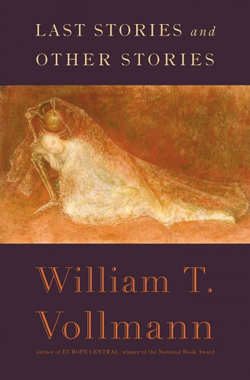Last Stories and Other Stories
by William T. Vollmann
reviewed by Okla Elliott
William T. Vollmann has a reputation as one of the most willfully idiosyncratic writers working today. He won the 2005 National Book Award for his novel Europe Central, but even before that he enjoyed a cult-like following due to his exploits in war zones and crack dens, as well as his voluminous output and oversized ambition as a writer. Last Stories and Other Stories is classic Vollmann in many ways—lyrical, lush, experimental in the best sense of that word, rawly honest in its vulgar and lofty obsessions.
Readers of Vollmann’s The Atlas will feel in familiar territory with such depictions of war-time calamity as “Escape” and “Listening to the Shells,” both set in Sarajevo during the Bosnian War. Those who appreciate the postmodern mix of mysticism and North American imperial history in Vollmann’s novel Fathers and Crows will enjoy seeing that vein of his work explored in “The Cemetery of the World.” Last Stories and Other Stories also includes pieces new to the Vollmann repertoire, such as the magical realist “The Cat Goddess,” a narrative populated by ghosts, mummies, animate statues, vampires, and the Virgin Mary. Throughout the collection, we are presented with deranged fairy tales, dark love stories between the dead and the living, and scenes of violence charged with supernatural electricity.
Here is a representative passage in “The Cat Goddess,” where a party is underway at the funeral of two dead (though still active) cats, Giulia and Lilith.
Beside Giovanna, applauding, sat a visitor from downstairs: a high-breasted mummy lady whose necklaces were faded in many colors and whose white belly was cracked right down to her mons veneris. With a sad fragrance of cypresses Our Lady now appeared to bless the funeral with tears which hardened into good luck pearls. She stretched out her hands, and Giulia crept into them unwilling-seeming, as if she could not help herself. Then the Madonna drew her in, cradling her against the Christ child’s cold stone head. Giulia began to purr. Then it was Lilith’s turn. So both were consoled for being dead.
I can imagine no other writer producing that passage, and it is this fierce idiosyncrasy that has caused such polarized views on Vollmann. His work is proclaimed brilliant and overrated with equal frequency, and Last Stories and Other Stories will suffer a similar fate. It has already received mixed reviews, as most of Vollmann’s books do.
But how does it stand up to his previous output? Quite well, in fact. Some of his most striking prose can be found here, as can some of his most imaginative scenarios. Vollmann fans are always looking for an entry point—a gateway drug of sorts—to hook first-time readers. Last Stories and Other Stories is perhaps the ideal candidate for such an introduction, given that it incorporates many of Vollmann’s literary tactics and thematic obsessions, while being one of his most accessible books in terms of readability. The pieces range from novella-length narratives to flash fiction of fewer than seventy-five words, offering a delectable variety of styles, structures, and subject matters.
Keeping with the undead theme of the book, Vollmann claims in a note to the reader that “this is my final book” and that “any subsequent productions bearing my name will have been composed by a ghost.” This is almost certainly a bit of postmodern fun of the sort Vollmann is well known for, but if it is his final book, it would not be a bad way to end a major career.
Published on February 25, 2015

